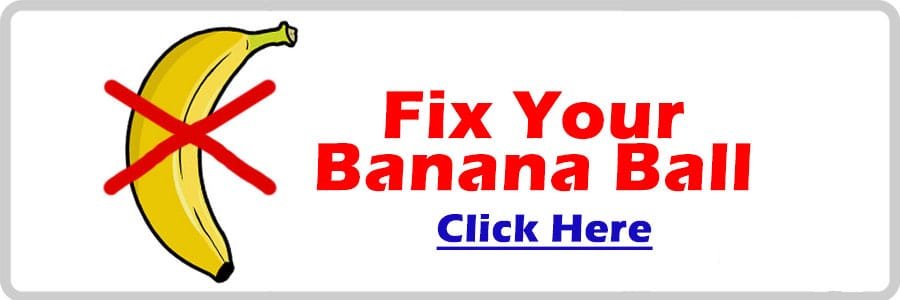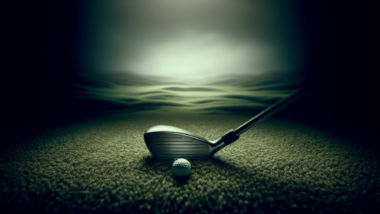Improving your golf game can feel overwhelming, especially when that pesky slice keeps creeping in. This article provides you with simple techniques to cure a golf slice in minutes, by breaking down the problem into manageable parts. You’ll learn how to address both spin and direction while mastering the toe-heel drill that can dramatically transform your shots.
By using your body’s natural motion and honing your swing mechanics, you’ll find that hitting straight shots becomes much easier. With a few practice steps, starting with a 7 iron before progressing to your driver, you really can cure a golf slice in minutes. Embrace the tips shared here, and you’ll be on your way to curing that slice and hitting the ball dead straight.
Understanding the Golf Slice
Definition of a Slice
A golf slice is a common shot shape that occurs when the ball curves dramatically to the right (for right-handed players) or to the left (for left-handed players) after leaving the clubface. Most golfers experience this at some point in their playing journey. It can be frustrating as it often results in missed fairways and difficulties in achieving desired distances, leading to unfavorable scores.
Common Causes of a Slice
Numerous factors can contribute to a slice, with the most significant being an open clubface at impact combined with an outside-to-inside swing path. When you set up for the shot, if your clubface is pointing right of the target while your swing path is cutting across the ball from outside in, you will impart excessive left-to-right spin on the ball, causing it to slice. Other causes may include poor grip, improper stance, and lack of body alignment, all of which can affect your swing dynamics.
Impact of a Slice When You Play
The consequences of slicing can be detrimental to your game performance. A slice often results in longer approach shots, penalties from going into hazards, and lost confidence on the tee. As a result, it can lead to a frustrating round of golf, with players losing strokes and feeling a decline in their overall enjoyment of the sport. Understanding and addressing the slice is crucial for improving your scores and making the game more enjoyable for yourself.
Divide the Slice Into 2 Parts
Step 1 – Fix The Spin
The first step to cure a golf slice in minutes is to break the problem into two main parts: spin and direction. Focusing on the spin is key because once you address this issue, you can begin to see improvements. The spin typically arises from an open clubface at impact, which creates that undesirable left-to-right direction for a right-handed golfer. By adjusting your grip and clubface orientation, you can begin to control the spin more effectively. In other words, do the drill in the video above and get the ball hooking first. You need to hook about 10 in a row before you move to step 2.
Step 2 – Fix The Direction
Once you have tackled the spin issue, the next challenge is to identify any direction problems. You might find that even with better spin control, your shots will be pull hooking. This can be attributed to your swing path. A proper swing path will ensure your ball travels on the intended line, so it’s essential to work on firing your body to fix your direction.
Importance of Fixing Spin First
Fixing the spin should always come first because it’s the primary cause of a slice. If you can consistently hit the ball with the correct spin, correcting the direction becomes significantly easier. When you focus on bringing the toe of the club to the finish line (as in the video above) before the heel during your swing, you eliminate all slice spin. Once you get the spin under control, focus on adjusting your direction, and you will see your game improve.
The Toe vs. Heel Concept
Understanding Club Face Orientation
It’s essential to comprehend how the orientation of your clubface at impact affects your shots. If the toe of the clubface releases early when you make contact, you will hit a hook. Conversely, if the heel is leading, a slice occurs. Therefore, focusing your training on ensuring that the toe of the club reaches the finish line before the heel will get you mastering step 1.
The Role of Club Position at Impact
Club position at impact plays a vital role in determining the outcome of your shot. When you practice hitting the ball, visualize the toe and heel “racing” to the finish line. Strive for the toe to arrive first; this not only reduces slicing but can also promote a more controlled, drawn shot. The more you embed this in your muscle memory, the more consistent your contact will be.
How to Master This Finish Line Drill
To master the finish line drill, it’s crucial to practice intentionally. Just hold the club slightly off the ground to make it easier to see at first. Once you get better at it, try it with a 7 iron that is teed up.
The Mechanics of Hooking
Why Hooking Is Better Than Slicing
While many golfers fear hooking the ball, it’s often more favorable than slicing. Hooking provides a much stronger shot shape that can lead to penetrating drives and tighter approach shots. Even though hooks can sometimes land far left of the target, they allow for better distance and a more beneficial overall trajectory.
Techniques to Transition from Slicing to Hooking
Transitioning from slicing to hooking requires a different thought. Instead of releasing the club early like you did in step 1 you need to switch to firing your lower body to start the downswing. If your lower body starts first you will hit the ball straight and cure a golf slice in minutes.
Benefits of Hooking in Golf
Hooking the ball provides several advantages. Primarily, it allows for better distance control and can lead to improved accuracy as it helps to counteract the natural tendency of the ball to float to the right on a slice. Moreover, once you get accustomed to a hook, you can refine it into more even trajectory shots that generally result in fewer lost balls and penalty strokes.
Mastering Swing Mechanics
The Role of Body Movement in Swing
Understanding the role of your body movement in your golf swing is crucial for mastering swing mechanics. Your body should serve as the primary driver of your swing, with your arms and club following naturally. You want to feel a smooth transition from your upper body into your arms during your swing motion.
Initiating the Downswing Correctly
The initiation of your downswing is critical in creating a successful shot. It should begin with your lower body and be driven by the motion of your hips and belt buckle. This allows for a natural uncoiling of your body, which in turn influences the swing path and face angle at the point of impact.
The Importance of Timing in the Swing
Timing is everything in golf. Developing a consistent rhythm and sequence in your swing will contribute to better outcomes. You want the movement of your body and arms to be synchronized in such a way that the clubface meets the ball with the correct orientation. Regular practice will help enhance your timing and ultimately improve your swing mechanics.
Effective Practice Steps
Starting with a 7 Iron To Make It Easy
Begin your practice sessions with a 7 iron instead of a driver. This club offers a more forgiving face and helps you focus on the fundamentals of your swing mechanics without the distance pressure of a driver. As you grow more confident and begin to see progress, you can slowly transition to longer clubs.
Move Up to a Driver When You’re Ready
Once you’ve made adjustments and have a more consistent swing with your 7 iron, it’s time to challenge yourself with the driver. Your focus should remain on maintaining the principles you practiced with the 7 iron and applying them to the longer club. Take your time, align accurately, and ensure your body movement stays coordinated as you progress.
Watch Your Shots
As you practice, pay careful attention to the feedback from each shot. Notice the ball’s flight path and adjust accordingly. When you make a good swing, celebrate those successes and reinforce those movements. If you still struggle with slicing, revisit your adjustments and refine your technique.
Visualizing Success
The Importance of Mental Imagery
Mental imagery is a powerful tool in sports. When practicing golf, visualize your ideal swing and the desired shot outcome. This technique can enhance your confidence and help you internalize the correct mechanics. Envisioning a successful shot will prepare your mind to execute it in reality.
Visualizing the Finish Line During Practice
Incorporate the concept of the finish line into your visualization exercises. Imagine the toe of your club approaching the finish line and focus on ensuring that it crosses before the heel. By establishing this mental picture, you’ll create a clearer awareness during your practice sessions, allowing you to reinforce this concept in your muscle memory.
Techniques to Enhance Visualization Skills
To strengthen your visualization skills, practice mindfulness or guided imagery exercises outside of your usual golf regime. Take a few moments each day to close your eyes and picture your desired swing mechanics, shot shape, and the satisfaction that comes from hitting straight shots. The more you engage in this mental practice, the more natural it will feel on the course.
Common Drills to Fix a Slice
Drills Focused on Body Movement
Implementing drills that focus specifically on body movement can help you correct your swing path and improve your overall technique. Try practicing with lag drills, where you emphasize the position of your hips and shoulders before letting your arms follow. Recording your swings can also provide immediate feedback to guide your adjustments.
Toe-Hit Drills to Promote Correct Impact
Develop toe-hit drills to practice getting the toe of your club to win the race to the finish line. You can set up these drills using alignment sticks or even visual markers on the ground. Make sure to reinforce the idea of rolling your wrists over and releasing the club in the correct sequence for optimal impact.
Repetitive Practice for Reinforcement
For lasting change in your swing mechanics, engage in repetitive practice. Frequent practice of the drills will help solidify the new habits you wish to establish. Consistency is key; set aside dedicated practice time each week where you can work on your grip, swing path, and follow through.
Utilizing Technology for Improvement
Using Video Analysis for Self-Assessment
Incorporating technology into your practice can lead to significant insights into your swing mechanics. Use video analysis to record your swing and review it systematically. This will allow you to see where you’re going right and where you can improve. Being able to visualize your form can be a game-changer in correcting slices and enhancing your technique.
Golf Simulators for Real-Time Feedback
Golf simulators offer an excellent way to practice without needing to be on a course. They provide immediate feedback on shot performance, allowing you to see the data behind your swings. You will have an opportunity to adjust your technique in real time and see the instant results of those adjustments.
Apps and Tools for Tracking Progress
Consider utilizing mobile apps or tools designed to track your golf progress. Many applications allow you to record scores and analyze your shots, making it easier to determine areas for improvement. Keeping detailed records can help motivate you to stay on track with your practice goals.
Conclusion
Recap of Key Techniques
To cure your slice effectively, remember to focus on these key techniques: address the spin before the direction, practice with the 7 iron to refine your swing, and visualize success through mental imagery. Ensure that you incorporate body movements into your swings and utilize technology for self-assessment.
Encouragement to Practice Regularly
Golf is a game that thrives on practice. Regular practice will help reinforce the techniques outlined and allow you to gradually eliminate your slice. Make it a habit to spend some time each week focusing specifically on these areas, as improvement comes with consistency and effort.
Final Thoughts on Curing a Golf Slice in Minutes
Curing a slice is undoubtedly a journey, but with the right mindset, techniques, and commitment to practice, you can transform your game. Embrace the joy of improvement and watch as your confidence grows along with your skills. Remember, curing a golf slice in minutes and hitting dead straight shots is within your reach. Happy golfing!







